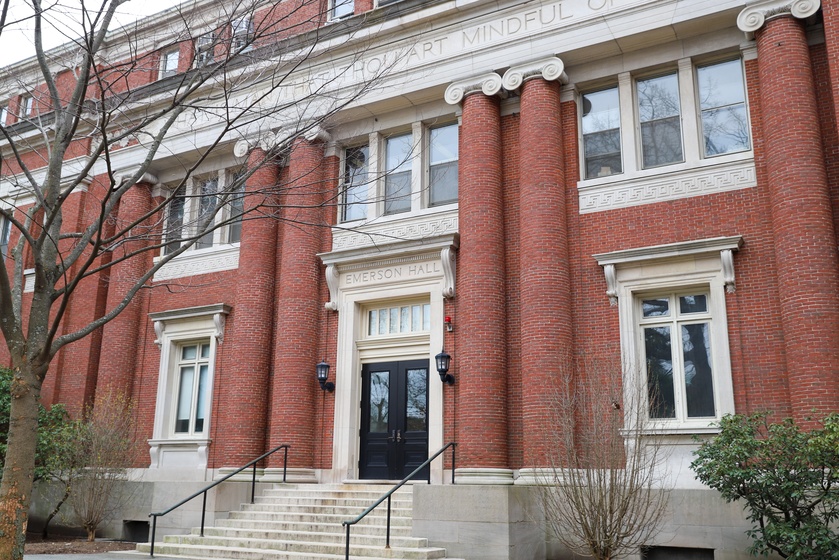{shortcode-c8d215c6d78218123c48f01ff546ef62b5dc969a}
{shortcode-8c0dd475ea3269f67b1a4d37d27db5cc232a1fc2}hen students walk into Harvard’s Emerson Hall today, they see white walls littered with posters promoting speaker events and surveys. But one century ago, students would have found the walls covered with photographs of immigrants facing the threat of deportation at Ellis Island, a group of boys fastidiously mending shoes at the Massachusetts School for the Feeble-Minded, and another photograph titled “seven little Indians in four different stages of civilization.”
They would be standing in the Social Museum Collection, a space created and curated by Francis Greenwood Peabody, a Harvard professor of Christian Morals.
The museum — which remained open from 1907 to 1931 and featured more than 5,000 graphic illustrations and photographs — weaved together a diverse set of experiences, from social settlements to racial tensions to industrial betterment.
In 1911, four years after the museum’s opening, Peabody wrote an essay for the Department of Social Ethics, where he explained that the Museum was the first attempt to “collect the social experience of the world as material for university teaching.” During an era of increasing transformation and industrialization, Peabody ardently believed in the importance of addressing the “social question.” As he wrote in 1886, “The problems of social reform are no longer subjects of which the educated can ignore… They are now the burning, if not tragic questions of our time.”
To inspire students to take action, Peabody began teaching classes on social ethics in the 1880s. His classes’ emphasis on personal responsibility and morality as the catalysts for social change were in line with the wider Progressive era beliefs.
Many of the museum collections showcased mass suffering and hardship. However, Peabody hoped that the museum would elicit sympathy rather than pity, and lead students towards a moral life centered around helping the less fortunate.
During the same era, a new wave of reformers began to view social issues from a scientific lens. Through inquiry and research, they analyzed housing problems, unemployment, and environmental conditions. It was with this shift that in the late 19th century to early 20th -century, Harvard, like other American universities, slowly evolved from classical religious-based educational institutions into modern research centers.
Peabody and his social museum captured this tension between the old and new approaches of the reform movement and the debate between religion and rationality. The museum approached social problems scientifically, epitomizing the era’s synthesis of ethics and reason.
As Peabody wrote in tThe Andover Review in 1887, “Science without sentiment is mechanism without steam, ingenious and complete, but without the dynamic which gives it motion and power.” He believed that ameliorating social problems necessitated both moral conviction and science-based solutions.
The museum’'s exhibits became a visual complement to Peabody’s classes on social responsibility. The photographs and materials transformed into anthropologic specimens and served as useful case studies in curing social ills.
Jackson Davidow, a Curatorial Fellow in Photography at the Harvard Art Museums, tells me about how the Social Museum revolutionized the use of photographs in the social sciences. Photography became more than an aesthetic tool — it served as a documentation and enabled a physical revisitation of society’s suffering.
“Their recontextualization elevated them to a different status because they circulated in a different capacity,” Davidow says.
Despite the Social Museum’s historical significance, its materials were only recently rediscovered. When Harvard’s newly established Department of Sociology absorbed the Department of Social Ethics in the 1930s, the Social Museum remained open. In the late 1960s, though, most of the photographs were discarded — they had to be rescued and housed by the Carpenter Center for the Visual Arts. The Museum of Modern Art displayed a small collection of the photographs in 1974. Finally, in 2002 the materials were transferred to the Harvard Art Museum and re-exhibited in 2007.
The reception of the Social Museum, however, has always been controversial.
As a 2007 New York Times article titled “Categorized, Compared and Displayed: Social Ills as Museum Specimens” argued, “Peabody’s idea of a Social Museum is somewhat absurd because nothing in it was truly a specimen, the way a bone or a meteorite might be for a museum of natural history.”
Even so, the Social Museum made waves within its field. As Davidow says, “the fact that it was being shown in the Museum of Modern Art was definitely breaking the mold.”


